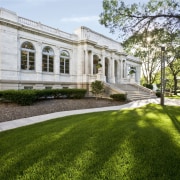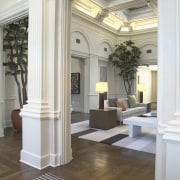Historic romance
This multifaceted heritage renovation celebrates the architectural sensibilities of the past and at the same time looks to the green imperatives of the here and now

Preserving and restoring a heritage-protected architectural structure comes with some 21st-Century challenges. Contemporary usage often has to be woven seamlessly through its hallowed bones, and the reconsidered building also has to sit well with a brave new world where sustainability is a key consideration.
The Phillips Family Offices building, built in 1901, embraces representative features of the classic Beaux Arts style large composition, exuberance of detail, and colossal columns. Added to the National Register of Historic Places in 1971, its interior had undergone several modifications. Domain Architecture & Design and GunkelmanFlesher Interior Design were asked to restore the building to its original charm and adapt it for modern office usage.
Deborah Everson, a principal architect with Domain, led the project from a restorative/heritage perspective, while fellow architect Michael Everson considered the former library building and its park-like surroundings from a sustainability point of view. Andrew Flesher, a principal at GunkelmanFlesher, was involved in all aspects of the design and selection of the interior finishes, furnishings and space planning. The project has attracted several awards for both heritage sensitivity and LEED-driven sustainability.
In terms of faithfully rejuvenating the Phillips Family Offices building, the exterior has been cleaned and restored, and in some cases substantial elements and detailing have been replaced with modern, economical equivalents.
Deborah Everson says the entire marble facade was cleaned, missing panels restored and the front steps replaced. The balustrade also needed to be replaced, as the original had been destroyed by acid rain.
"To replace this significant feature, we used cast marble matched to the colour and shape only the original caps on the balustrade have been retained," says Deborah Everson. "Dilapidated windows were replaced with custom replica clad windows these are wood on the inside but painted aluminium on the outside, making for a robust, economical and accurate representation of what had gone before."
Besides restoring the exterior, the architects were asked to introduce wheelchair access into the building. This took the form of a contemporary addition to the south-facing rear of the structure.
"While this decidedly modern add-on stands in contrast to the classic Beaux Arts style, sympathetic proportions of fenestrations and iteration of the three-bay patterning help draw the two together," Deborah Everson says. "The addition was primarily to provide disabled access to the main level of the building and the basement. Impact on the main structure was kept to a minimum, with only a straight cut through the wall required to assimilate the addition, a generous stairwell and a passenger lift."
On the inside, interceding renovations were stripped away and built afresh, all in complete sympathy with the original building. A dramatic find was made along the way a set of nine intricate skylights over the central lobby at the heart of the building, which ceiling panels from an earlier renovation had obscured.
"These windows, their iconography still a mystery, were taken down, carefully restored and replaced, with soft back lighting added to create the effect of filtered daylight even at night," says Deborah Everson.
Generally, Everson and Flesher let the original solid masonry interiors speak for themselves. Where areas needed to be sectioned off for offices or the large conference room, the sound and privacy dividers were placed in visually unobtrusive glass partitioning walls.
Taken from a sustainability viewpoint, the project assumes an even broader scope, including a reworking of the surroundings, an oasis of green within an inner-city suburb. Michael Everson refers to this as a whole-site approach.

"Together with preserving the existing established elements, such as the mature trees, we sought to increase the ratio of open, pervious ground to development footprint," he says. "This was to enhance the look of the greater site and to eliminate rainwater pollution from the area. Previously, heavy rains had seen storm water run off impervious areas of the 2752m² high-ground site, such as the substantial car park, and flood into adjacent streets."
Everson addressed this on several fronts. A non-porous, surfaced alleyway was removed and replaced with a modest walkway. The rest of this area was restored as pervious, vegetated open space. Similarly, the car park to the east of the site has been greatly reduced in size, with the resulting freed-up space also reclaimed as water-absorbing grass. The water from the reduced car park is trained into a swale, dissipating excess runoff directly into the ground.
Several LEED-driven highlights include a closely monitored waste-reduction plan, allowing over 90% of all removals, construction and demolition waste to be diverted from landfill. The building incorporates a systemic, energy-saving roof covering, high-efficiency HVAC systems, Energy Star-certified equipment and appliances, and efficient lighting components and systems controls, with total energy consumption projected to be reduced by over 19%.
As with all focused sustainable projects, all paints, glues and carpeting have low VOC and where possible, elements were sourced locally.
The renovation of the Phillips Family Offices reflects detailed consideration at every turn right down to its art gallery-like interiors, dressed with classic furniture design pieces. Domain Architecture & Design and GunkelmanFlesher Interior Design have addressed this historic building with every respect for the past and equally, every respect for the future.
Credit list
Architect
Interior designer
Mechanical and electrical engineer
Structural engineer
Electrical
Masonry
Roof
Window and door joinery
Blinds
Flooring
Ceiling
Lighting
Awards
LEED compliance and certifications consultant
Construction, civil engineering, landscaping
Historical consultant
Lighting design
Plumbing
Stained glass
Facade
Hardware
Drapes
Wallcoverings
Paints
Furniture
Story by: Charles Moxham
Home kitchen bathroom commercial design













